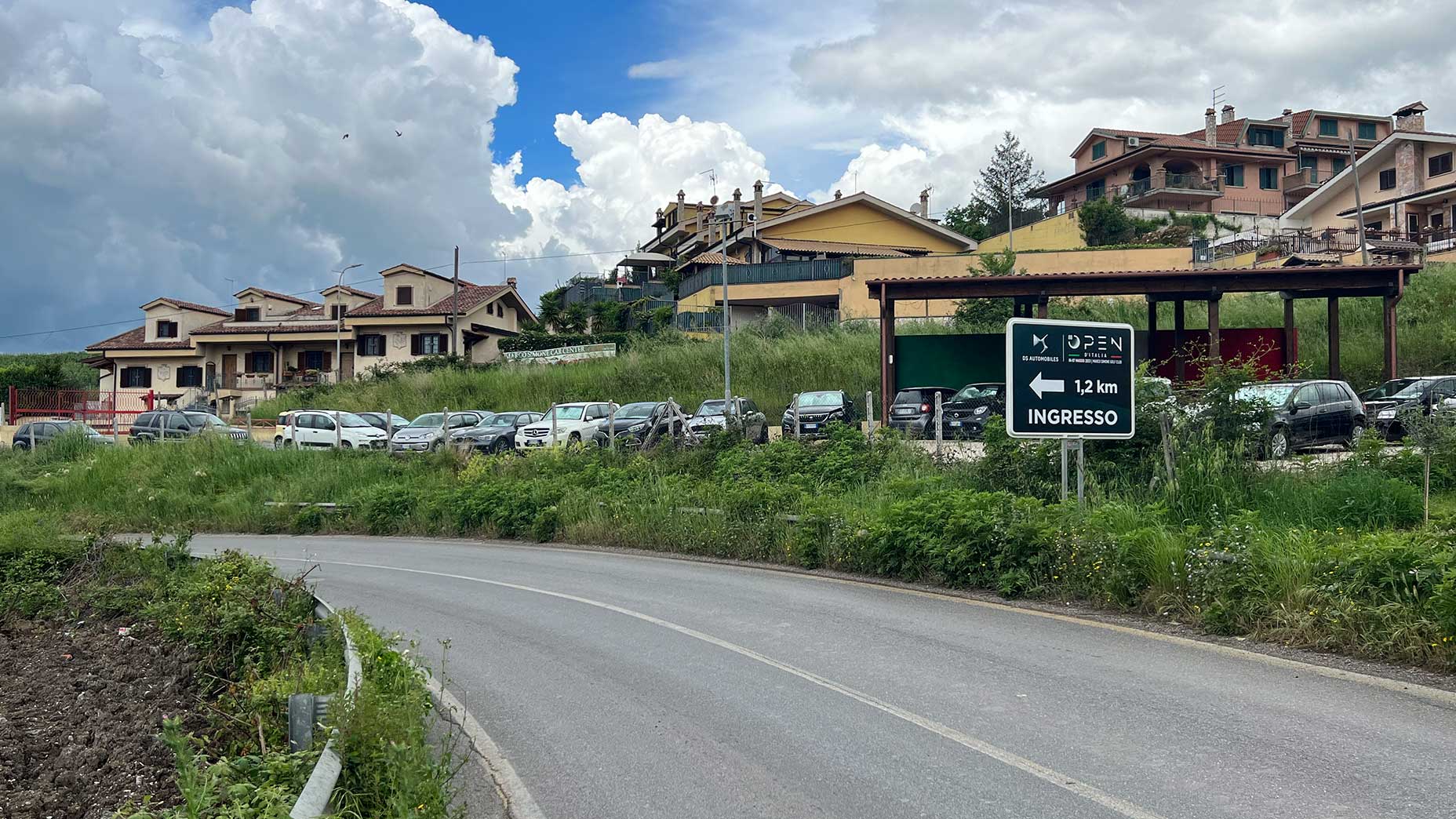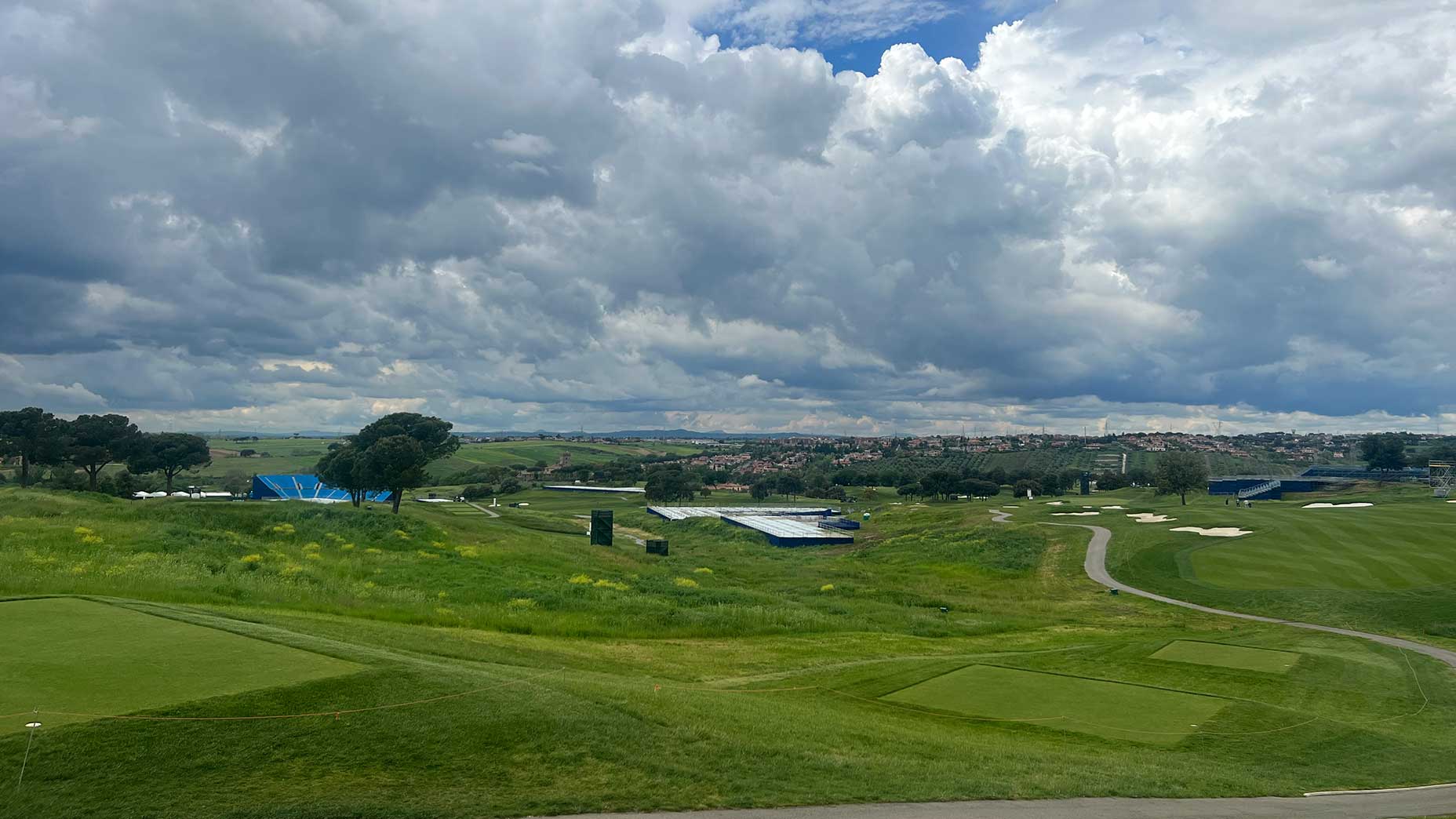
Rome looks picturesque as ever, even if the golf course still has some growing to do.
James Colgan/GOLF
MARCO SIMONE, Italy — Rome is drowning.
Tourists have flooded the capital city for Labor Day, for one thing. But that’s the second kind of flood; the locals are more concerned with the traditional type. Steady rain arrived from the east and doused the city all weekend, transforming selfie-stick salesmen into umbrella hawkers. Now, on Monday, a second storm is blowing in from the west, threatening to submerge the annual beginning-of-summer party altogether.
For a city so well-trafficked in architectural and civic feats, Rome seems dreadfully equipped for this weather. Large pools of water form over the ash-colored cobblestones that line most of the narrow streets. Up above, slate rooftops redirect water from earth-toned buildings to pedestrians in enormous globs. The sewers should help, but it’s hard to know which of the street-adjacent cement craters are for runoff and which ones are just potholes.
It’s been that kind of spring in Italy, where April showers are threatening to earn a May encore, sticking around to drench the first of the high season. There’s a saying about the rain here: piove sempre sul bagnato (rough translation: it always rains on the wet). The locals use it to describe people who find themselves lavished in good fortune.
This is just the beginning of tourist season, and Summer ’23 promises to be a record-breaker. But from where I sit, Rome will be saving the best for last. After a red-hot high season rolls through town, the Romans will usher in the fall by hosting the only golf tournament befitting their city’s heart-throbbing flair for drama: the Ryder Cup.
It will be the biggest tournament in Italy’s golf history and also the most significant Ryder Cup in decades. With the attention of a deeply divided golf world turning in Rome’s direction, maybe the rain is cleansing in more ways than one.
I ARRIVED AT MARCO SIMONE GOLF CLUB as part of a vacation detour. And, like all worthwhile vacation detours, that arrival nearly came at the cost of my life.
The only mistake made by those visiting Marco Simone Golf Club is believing in the existence of the neighboring town of Marco Simone. There are houses, yes, and a few disparate shops. But nothing else. No town square. No distinct buildings or markings. Hardly even a street sign. English is spoken fluently throughout Rome, but not in Marco Simone, where the few people around speak only the native tongue.
“Is this … what you were expecting?” Jamie, my girlfriend-turned-coconspirator, asked flatly upon our arrival in “town.”
I shrugged.
“Do you know what you’re supposed to be seeing?” she asked again.
“Yeah,” I said, mostly lying. “The golf course is just up the road.”
As it turns out, the entrance to Marco Simone Golf Club is just a quarter of a mile from the “center” of Marco Simone. But for the non-vehicularly inclined, the walk up the narrow, terrifying road that separates them bears a striking resemblance to the 38th parallel.
Our journey up the road’s nonexistent “shoulder” began just as a parade of cars ripped around the S-turn in front of us, buzzing their horns angrily in our direction as they passed.
“Do we … HAVE to do this?” Jamie asked, a Vespa whizzing by her right shoulder.
“I think so,” I yelled back.
We took two more steps.
“I think I can see it—” I said, but before I could finish the thought I was interrupted by the side-view mirror of a semi-truck, which whistled so close to my ear that its wake tussled my hair.
“Okay,” I said, finally relenting. “Let’s go somewhere else.”
Jamie pointed out to a group of ominous clouds in the distance.
“Maybe it’s just as well we don’t go that way.”

James Colgan
I FELL IN LOVE WITH ROME the way the locals seem to: by slowly forgetting to hate it.
We arrived to find the Eternal City in the midst of an existential crisis. On the first major summer weekend, there were simply too many people and too few places for them to go. The gruff underbelly of the city — its kitschy, overcrowded, slowly dilapidating side — wasn’t an underbelly at all; it practically smacked you in the face as you walked through the streets.
At the Colosseum, even the ticket scalpers seemed overwhelmed by the constant flow of new business, struggling to capture the attention of the thousands of tourists pushing through each instant. Down in Trastavere, supposedly a local food haven, the trattorias were overrun; those who hadn’t snagged an online reservation were turned away at the door. And in the Vatican City, Moses himself couldn’t have parted the line outside the Sistine Chapel, which stretched through St. Peter’s Basilica and straight back into Rome.
Out on the streets, the mood is mostly chaos. Tour groups terrorize the city streets, blocking up oncoming traffic. Taxis plow through narrow walkways with a general ambivalence toward pedestrian safety. Tourist traps are more frequent than gelato stands; some are gelato stands.
“Take the train,” advised one frustrated Roman. “It’s the only thing in this city that works.”
This, it seems, is Rome’s curse. After two Covid summers gave way to a sardine-packed 2022, Summer ’23 will be the city’s largest ever. The problem, as many a Roman will tell you, is that no 2,000-year-old city, not even Rome, can handle the hordes that will soon arrive. To live in Rome in the summer is to live in bedlam.
And yet this is precisely what makes the city’s acquired taste so intoxicating to some. For those who aren’t overwhelmed by the constant crowds and tourists and chaos — those who learn to embrace the drumbeat — there’s a deeply enchanting world brimming underneath the cobblestone.
At night, the walkway surrounding the Colosseum is no longer a tourist haven. Instead it’s both jaw-dropping and empty; perfect for an evening stroll. And with time city wanderers learn the confusing, vein-like street system can make it easy to dodge crowded pockets in an instant, as many of the offshoots lead to some of the city’s best wine bars and restaurants. The online reservation system may violate the essence of Italian food culture, but it’s more accessible and reliable than other major cities — and one bite of authentic carcioffo alla Giudia (deep-fried artichoke) or coda alla vaccinara (oxtail stew) more than makes up for the inconvenience.
As for the golf? The golf isn’t half-bad, either. The Romans seem to carry the honor of hosting the Ryder Cup with the same unquestioned self-seriousness they carry near everything else. From afar, I worried that approach would drag the event into an ornate display of Eurocentrism. I don’t worry about that any longer.
It’s clear that Italian golf isn’t in the same echelon as many of its European siblings. The list of Italian major championship winners runs precisely one name long: Francesco Molinari, whose victory at the 2018 Open Championship remains the country’s crowning golf achievement. In recent years, Italian pros have climbed into prominence, but a glance at the Official World Golf Ranking reveals none are in serious contention for a Ryder Cup spot at present. In all likelihood, the only Italian professional golf presence at the event will be Edoardo Molinari, who was selected by captain Luke Donald as an assistant captain.
The golf course is a fitting microcosm for that history. Marco Simone remains unranked in most major lists, but the course proved a proper test of mettle for the week’s Italian Open. At 7,255 yards of lush fairway and punishing rough, it’s easy to see how the course setup could be tilted in the Europeans’ favor against a ball-striking U.S. squad. The greens are deft and undulating, while water and wind could prove terrifying match play factors. Adrian Meronk, an Austrian pro, won the Italian Open at just 13-under. Meronk was, perhaps not coincidentally, the only pro in the field to shoot four consecutive rounds under-par.
Most of the Italians I spoke with are aware of their country’s limited golf history, but near all of them seem eager to learn more. Of course, that will manifest itself in a few over-the-top eccentricities — one Florentine leather shop is selling a custom Italian leather staff bag for the “negotiable” price of $3,000 — but far more often it will manifest itself in an earnest excitement for the Ryder Cup’s bleeding-heart passion and tradition.
There’s been no lack of passion in pro golf these last couple years. There has been a distinct lack of unification. The Ryder Cup will bring the former; whether it will bring the latter is less clear. The game will enter Rome on the heels of its second season since the great Tour schism, and the Cup could well serve as a striking reminder of golf’s division, with LIV players potentially left off team rosters in favor of PGA Tour counterparts with thinner resumes. But it could also serve as a reminder of the unifying power that has endeared golf — and in particular, this international competition — to sports fans worldwide for the better part of a century.
Golf’s obsession with the phrase “grow the game” may finally be waning, but the work of building the sport persists every day. Rome presents a real, tangible, measurable way to expand golf’s fanbase with a massive, sport-loving population; to do what Seve did for Spanish golf, or what Hideki continues to do for Japan. It’s hard not to feel excited for the Italians who will experience golf for the first time come September, and for what it means for the rest of us.
But that’s assuming the Ryder Cup can reach the Romans at all. In Marco Simone, the owner of Enry Bar — a lovely café that is one of the town’s only brick-and-mortar establishments — was shocked to see tickets on the secondary market priced for as much as €400 daily.
“Tickets? For one day?! I love A.C. Roma,” the owner said incredulously. “I would never spend that much.”
Then he chuckled.
“I hope the weather’s good.”

GOLF/James Colgan
EVENTUALLY, WE FOUND THE GOLF COURSE.
Not via the front entrance, mind you, but from the wrong side of a fence separating the 12th fairway from an apartment complex. Still, the vantage point was good and the risk of becoming roadkill low, so there was little reason to complain.
As luck would have it, we’d arrived on Tuesday of Italian Open week, meaning our early-afternoon travels had overlapped with a handful of DP World Tour practice rounds.
Soon a group of pros arrived on the tee box in front of us, exchanging polite waves as they strolled by.
“Things looking Ryder Cup-ready?” I asked down in the direction of one of the pros, an Italian named Aron Zemmer.
“I hope not,” his caddie replied, pointing in the direction of a massive, half-built grandstand in the distance. “I hope there’s more of that.”
The group disappeared into the fairway, but before another could arrive, a man popped out from an apartment behind us. He was older, maybe in his late-60s, and a crop of gray hair fell over his ears. It was nearly 85 degrees, but the man wore a gray jacket and jeans. He carried a maroon umbrella in his hands.
“Are you here to watch the golf?” He asked with a kind smile.
“Yes,” I replied. “Are you?”
“No, I live here,” he said.
“Do you like to play, or just watch?”
“Just watch,” the man said.
He looked on intently as another group of golfers sprawled tee shots out into the fairway. He was delighted by their precision, offering applause and a few too-loud words of encouragement. Some golfers shot confused glances back in his direction. He turned to me again and laughed.
“The big tournament is coming here in September,” he said innocently. “I just wanted to see how they looked.”
I laughed, though the man seemed to understand that my Italian fell short of fluent.
He pointed his umbrella up at the slowly worsening sky and offered one last smile.
“You should hurry,” he said. “The rain is coming.”

James Colgan/GOLF








